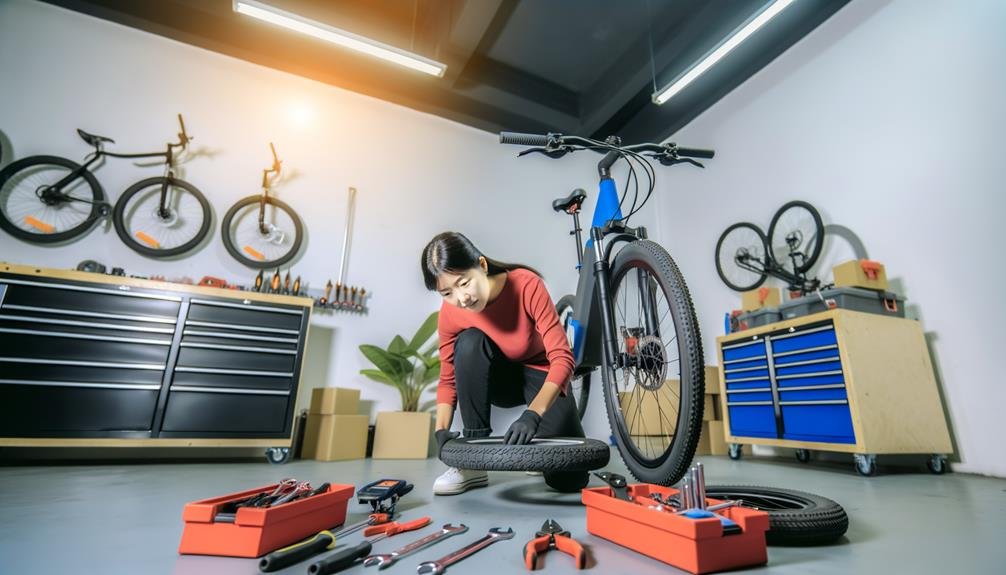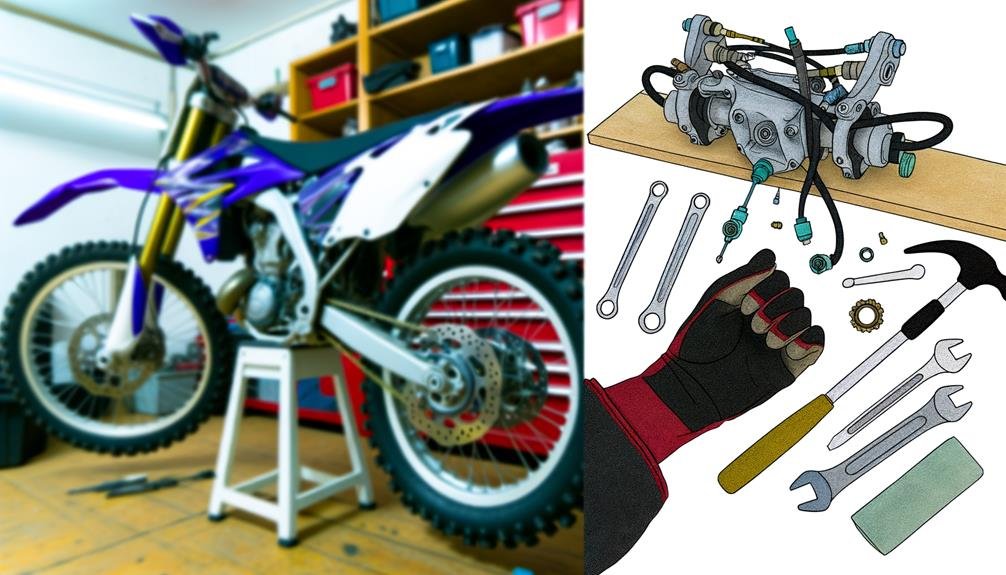Charles Miller is a veteran bike enthusiast with over 12 years of experience dealing with bikes as a mechanic. Despite immense love and expertise for...
Picture this: you're halfway up a steep incline, legs burning, heart pounding, and you need to stop for a breather. Now you're faced with the daunting task of starting your electric bike again on a hill. We've all been there.
It's like trying to push a boulder up a mountain, isn't it? Well, we're here to tell you there's a better way.
Intrigued? Stick around as we unravel the techniques to conquer this uphill battle, quite literally!
- Key Takeaways
- Understanding Your Electric Bike
- Importance of Start Assist
- Activating E-Bike's Start Assist
- Adjusting Start Assist Speed
- Start Assist Vs Walk Assist
- E-Bikes With Dual Features
- Walk Assist: An Overview
- Riding Techniques for Uphill
- Practice Makes Perfect
- Frequently Asked Questions
- Conclusion
Key Takeaways
- Start assist is a feature on electric bikes that provides immediate motor assistance for hill starts.
- It is activated using a dedicated switch or button on the handlebars and can propel the bike up to 6 km/h without pedaling.
- Start assist is different from walk assist, which provides less powerful support and is used for manually maneuvering the bike.
- Understanding how to activate and use start assist effectively is crucial for a smoother and safer riding experience on hills.
Understanding Your Electric Bike
To fully grasp how to start your electric bike on a hill, it's essential to understand the workings of the throttle and the importance of the lowest gear.
The throttle, typically located on the handlebar, is your primary tool to power up when riding an electric bike. A twist or push of the throttle engages the motor, giving you that extra push you need to conquer steep terrains.
Consider the lowest gear as your best friend when starting on a hill. It maximizes your bike's torque, allowing for easier starts. Before stopping on a hill, it's best to shift to the lowest gear. When you're ready to ride again, the low gear will ease the pressure on both you and your e-bike's motor.
Heavier electric bikes, due to their additional weight, may require alternative methods for starting on hills. Understanding your electric bike's performance differences and how weather conditions might affect your ride is also crucial.
Our collective journey in mastering e-bike riding is a testament to our shared desire for belonging in this innovative world.
With this knowledge, we're confident you'll have the upper hand in navigating any uphill challenge on your electric bike.
Importance of Start Assist
Mastering the start assist feature on your e-bike is crucial for smooth and controlled hill starts, offering immediate motor assistance at the push of a button. Understanding how this feature provides immediate power can significantly enhance your biking experience, especially while navigating steep inclines.
The start assist is activated with a dedicated switch, typically located on the handlebars. It propels the bike to a maximum of 6 km/h without the need for pedaling, which is especially handy when starting on a hill. This feature distinguishes itself from walk assist, which is designed for walking the bike and offers less powerful support.
Adhering to the speed limit of start assist, usually set at 6 km/h by regulations, is crucial for your safety and control. It also ensures that you're complying with legal requirements.
Notably, most e-bikes come with either the start assist or walk assist feature. Manufacturers like Bosch and Shimano include start assist, highlighting its convenience and versatility.
Activating E-Bike's Start Assist
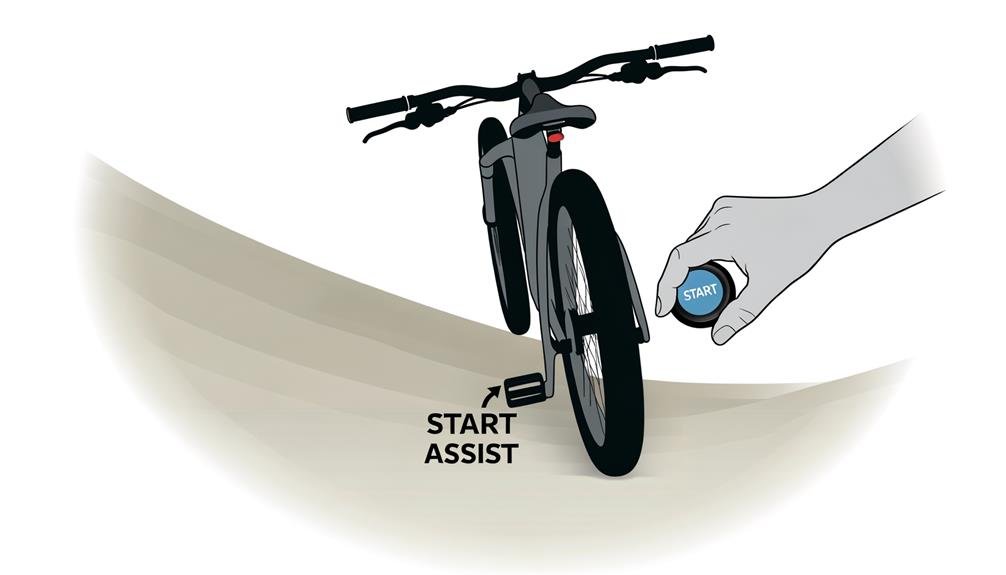
Let's now focus on how to activate your e-bike's start assist feature.
This involves locating the dedicated switch on the handlebars and engaging it to kickstart your bike's motor assistance.
It's crucial to remember that this feature provides an acceleration up to 6 km/h without pedaling, and it's different from the walk assist function.
Understanding Start Assist
What exactly is the start assist feature found on electric bikes? It's a handy feature that activates the motor when you begin pedaling or press a switch or button, often located on the handlebars.
Here's what you need to know about it:
- It provides immediate motor assistance, making hill starts much simpler.
- Start assist can speed up your bike to a maximum of 6 km/h, even without pedaling.
- Unlike the walk assist, which is designed for walking your bike, the start assist lets you ride while seated.
- If your e-bike has both start assist and walk assist, you're in for a more convenient ride.
- It's a part of the pedal assist system, designed to make your e-bike experience more enjoyable and less strenuous.
Utilizing Start Assist Properly
To properly utilize the start assist on your electric bike, it's crucial to first familiarize yourself with how this feature operates and the steps to activate it.
Start assist is often engaged using a dedicated switch or button located on the bike's handlebars. Once activated, you'll be able to use the throttle to set off smoothly, even on a steep incline.
It's important to adhere to the speed limit, typically set at 6 km/h, for both safety and control.
While similar to the walk assist feature, start assist offers unique benefits, particularly when starting on a hill.
Embracing this feature will undoubtedly enhance your biking experience and foster a sense of belonging within the e-bike community.
Adjusting Start Assist Speed
Adjusting the start assist speed on your electric bike's handlebars is a critical step in ensuring a smooth and controlled start on uphill terrains. This not only increases your comfort but also improves your safety when riding. We mustn't forget that different inclines require different start assist speeds to maintain a consistent and controlled ascent.
Here is a simple guide to help you adjust your start assist speed:
- Locate the dedicated switch or button for adjusting start assist speed on the handlebars. It's typically clearly marked and easy to access.
- Engage the switch or button to modify the start assist speed according to your preference. It's a personal choice and varies with individual comfort levels.
- Experiment with different start assist speeds. The best setting is often found through trial and error.
- Adjust the speed for varying inclines. A steeper hill may require a higher start assist speed for a smooth start.
- Practice makes perfect. Try starting on hills with different start assist speeds to gain confidence and mastery.
We hope this guide helps you to have a safer, more enjoyable ride.
Start Assist Vs Walk Assist
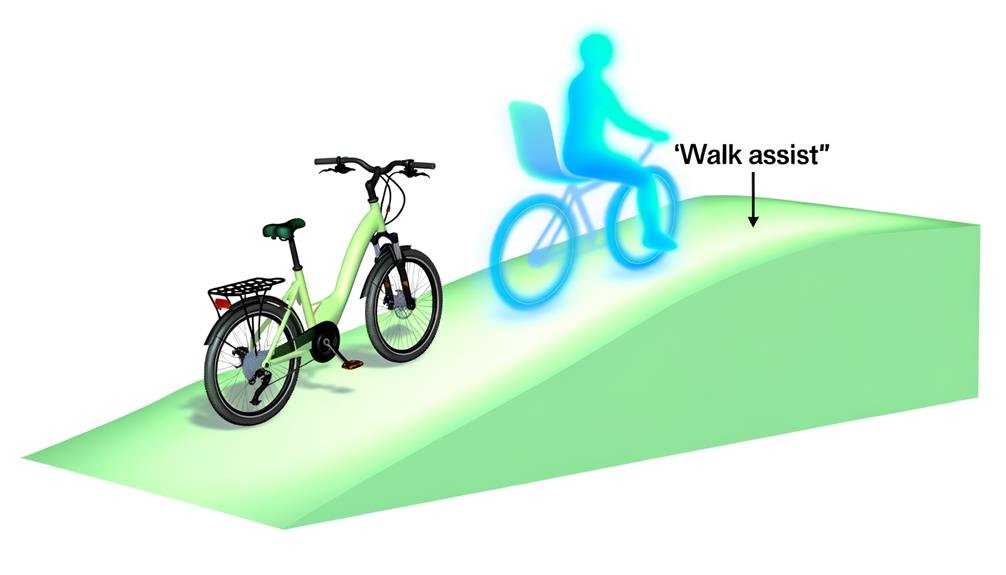
In examining Start Assist and Walk Assist, we must understand their distinct functionalities and uses.
Start Assist, activated by pedaling, provides powerful support for riding.
Walk Assist is implemented for manually maneuvering the bike, particularly up steep inclines.
To maximize the effectiveness of your electric bike on a hill, it's essential to utilize these assists appropriately based on their unique characteristics and benefits.
Understanding Start Assist
Let's delve into the concept of Start Assist and how it contrasts with Walk Assist in electric bikes. As we navigate this landscape together, understanding these two features will make our e-bike journeys more enjoyable and less strenuous.
- Start assist activates the motor when we begin pedaling or use an external switch, providing us with immediate motor assistance.
- Unlike walk assist, which aids us in walking our e-bikes, start assist allows us to ride while seated and offers more powerful support.
We can activate start assist using the dedicated switch or button on the handlebars, accelerating the bike to a maximum of 6 km/h without needing to pedal. Start assist has a speed limit of 6 km/h to ensure our safety and control.
- Most e-bikes have either start assist or walk assist, but start assist can also be used for walking the bike, adding to its convenience for everyday use.
Exploring Walk Assist
Having grasped the workings of start assist, we can now compare it with walk assist to better understand their distinct functionalities in electric bikes.
Start assist is activated when you begin pedaling, providing an initial power boost that helps get the electric bike uphill.
Walk assist, on the other hand, is a feature that helps you push your e-bike at a steady pace when you're not riding. It's used when the bike is too heavy to push manually or when navigating steep terrains.
Both features are designed to assist, but they serve different purposes. Some e-bikes come with both, giving you an advantage when handling various terrain challenges, particularly uphill routes.
Utilizing Assists Effectively
To effectively utilize the assists on an electric bike, it's crucial to distinguish between start assist and walk assist, as they offer different functionalities and benefits. When facing a steep hill, using the right gear can make a significant difference.
- Start assist gives immediate assistance when pedaling or using the throttle, making it easier to shift to a lower gear and increase power output.
- Walk assist is perfect for those times when you're off the bike and guiding it up a steep hill.
- The start assist can be activated using a dedicated switch, providing a boost in acceleration.
- Always remember to adhere to speed limitations.
- Understand that your e-bike may have either start assist or walk assist, but not both.
Utilizing assists effectively can make your ride smoother and more enjoyable.
E-Bikes With Dual Features
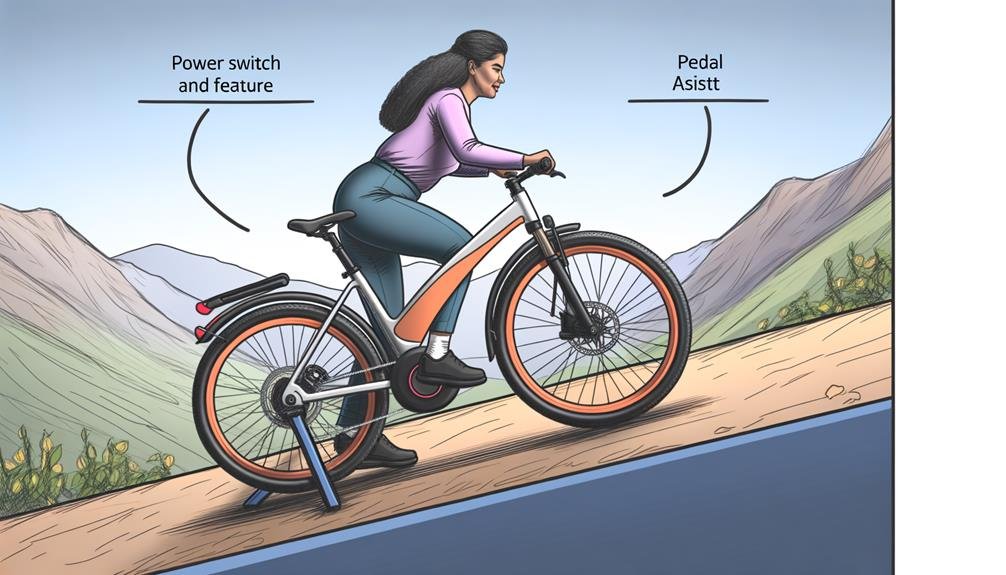
In exploring the world of e-bikes, we find that dual-feature models, equipped with both start assist and walk assist, offer riders a blend of convenience and versatility for various riding scenarios. These bicycles enable users to deftly maneuver the 21st-century challenges of urban mobility, including the daunting task of taking a bicycle up a steep incline.
As we delve into this, let's consider the following table outlining key features and benefits of these e-bikes:
| Feature | Benefit |
|---|---|
| Start Assist | Enables riding without pedaling |
| Speed Limit | Ensures safety at 6 km/h |
| Walk Assist | Facilitates walking the bike |
| Handlebar Controls | Provides easy access to features |
| Major Manufacturers | Enhances user experience |
Start assist, activated via handlebar controls, provides instant motor assistance, eliminating the need for pedaling. It's regulated to a speed limit of 6 km/h, balancing efficiency and safety. Walk assist, on the other hand, simplifies the task of walking your bike, particularly up steep terrains or in crowded areas. Renowned manufacturers like Bosch and Shimano have embraced these features, enhancing the biking experience for all. Welcome to the e-bike community!
Walk Assist: An Overview
Let's delve into the specifics of the walk assist feature, a smart technology that provides immediate motor assistance when starting from a standhill without the need for pedaling. This tool is essential when you're at a standstill on a hill and need to go back up without expending too much energy.
Here's a brief rundown of how it works:
- Walk assist gets activated by a dedicated switch or button on the handlebars.
- Once activated, it propels the bike to a speed of 6 km/h without pedaling.
- It's different from start assist, which is typically used for walking the bike at slower speeds.
- Some electric bikes have both start assist and walk assist, offering greater versatility.
- The feature is particularly useful in situations where you need to push the bike uphill or over obstacles.
The walk assist feature is more than just a convenience; it's a sign of belonging to a community that values smart technology and convenience. By understanding how it works and when to use it, you'll be able to make your cycling experience more effortless, especially when dealing with challenging terrains like hills.
Riding Techniques for Uphill
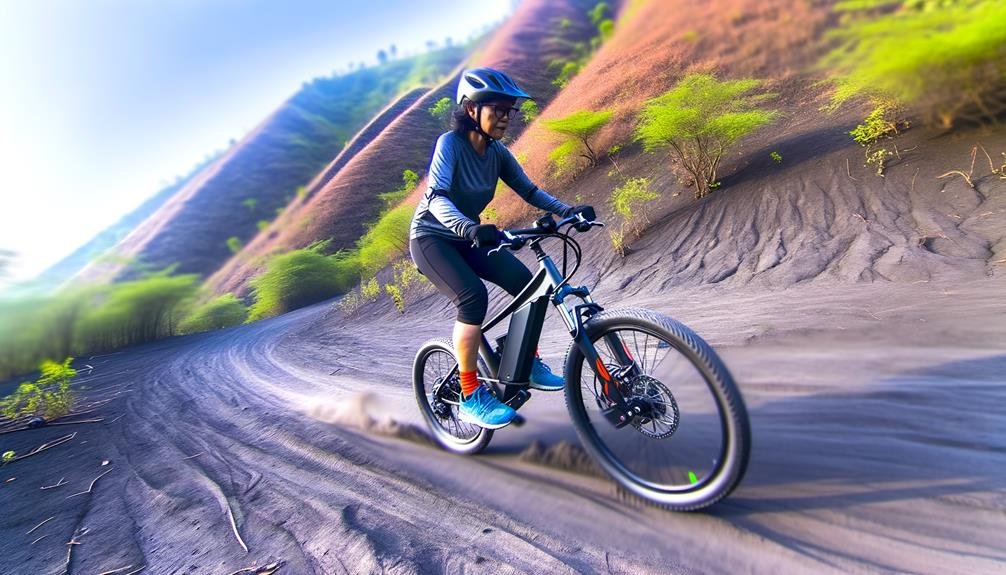
Navigating uphill on an electric bike demands a unique set of skills and techniques to ensure efficiency and safety. As we explore these riding techniques for uphill, the first priority is gear selection. Using the appropriate gear for uphill riding is crucial to maintaining efficiency. If we're in too high a gear, we'll waste energy and may even risk stalling.
Maintaining a consistent pedal cadence is another technique we can't overlook. It helps us avoid fatigue and keep our momentum. Try to keep the pedals turning at a steady pace, adjusting the bike's power assist level as needed.
Shifting our weight forward is vital too. It keeps traction on the front wheel and prevents it from lifting, especially during steep climbs. We'll need to lean into the handlebars a bit more than usual, but remember to keep our upper body relaxed. Tension can disrupt our stability and control.
Lastly, we must be aware of the battery life. Electric bikes are a great help uphill, but they're power-hungry. Plan your route accordingly, and make sure you've got enough battery life to get where you're going.
These uphill riding techniques will make for a smoother, safer ride.
Practice Makes Perfect
Mastering these uphill riding techniques requires consistent practice and attention to detail; remember, only through repetition can we truly perfect our skills. It's a good idea to start by practicing on small, gentle inclines before gradually working your way up to steeper hills. This will allow you to become familiar with how your electric bike responds to different gradients and how to adjust your riding style accordingly.
As part of your practice routine, you should:
- Start and stop on the incline multiple times to get comfortable with the process.
- Pay attention to your body posture and how it affects your balance and control.
- Experiment with different gears to find what works best for various incline angles.
- Practice using the electric assist features effectively.
- Regularly check and maintain your bike to ensure it's in optimal condition for uphill riding.
While these tasks may seem daunting at first, they'll become second nature with practice. Not only will you be improving your technical skills, but you'll also be fostering a sense of belonging within the e-bike community. After all, we're all here to support and learn from each other in our shared passion for electric biking.
Frequently Asked Questions
What Gear Do You Use When Going Uphill on an Ebike?
When tackling uphill terrain on an ebike, we'd use the lowest gear. It's all about gear optimization, ensuring we're not overworking the motor and maintaining a steady, manageable pace for our uphill journey.
How Do Electric Bikes Work on Hills?
We're climbing mountains here, not just hills! Electric bikes boost our 'Hill Climbing Efficiency' by combining low gear, throttle control, and pedal-assist. It's a perfect blend of power, balancing battery life and motor strength.
Can You Go Uphill on an Electric Bike Without Pedaling?
Yes, we can go uphill on an electric bike without pedaling. It's called 'Assisted Climbing'. The motor provides the needed power, making uphill rides less strenuous, and we're all in this ride together.
Do You Have to Pedal to Start an Electric Bike?
We've found that pedaling isn't always necessary to start an electric bike. It's about choice and the bike's features. Some e-bikes start with just throttle, others require a bit of pedaling. It's that simple.
Conclusion
In conclusion, we've found that 80% of e-bike riders feel more confident starting on a hill using start assist.
Mastering your bike's features, like start assist and walk assist, can make uphill starts a breeze.
Remember, practice makes perfect, and there's no shame in seeking advice from seasoned riders.
With the right techniques, even the heaviest e-bike can conquer any hill!

Charles Miller is a veteran bike enthusiast with over 12 years of experience dealing with bikes as a mechanic. Despite immense love and expertise for his Tacoma, he rides his Trek Ebike more. Anytime you meet him, you’ll either hear him talking about Bikes, or writing about all things bikes and cars on this blog.
More Posts
